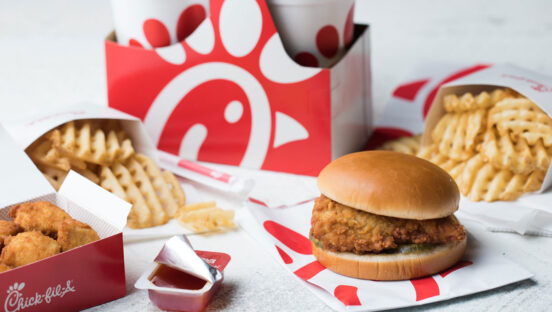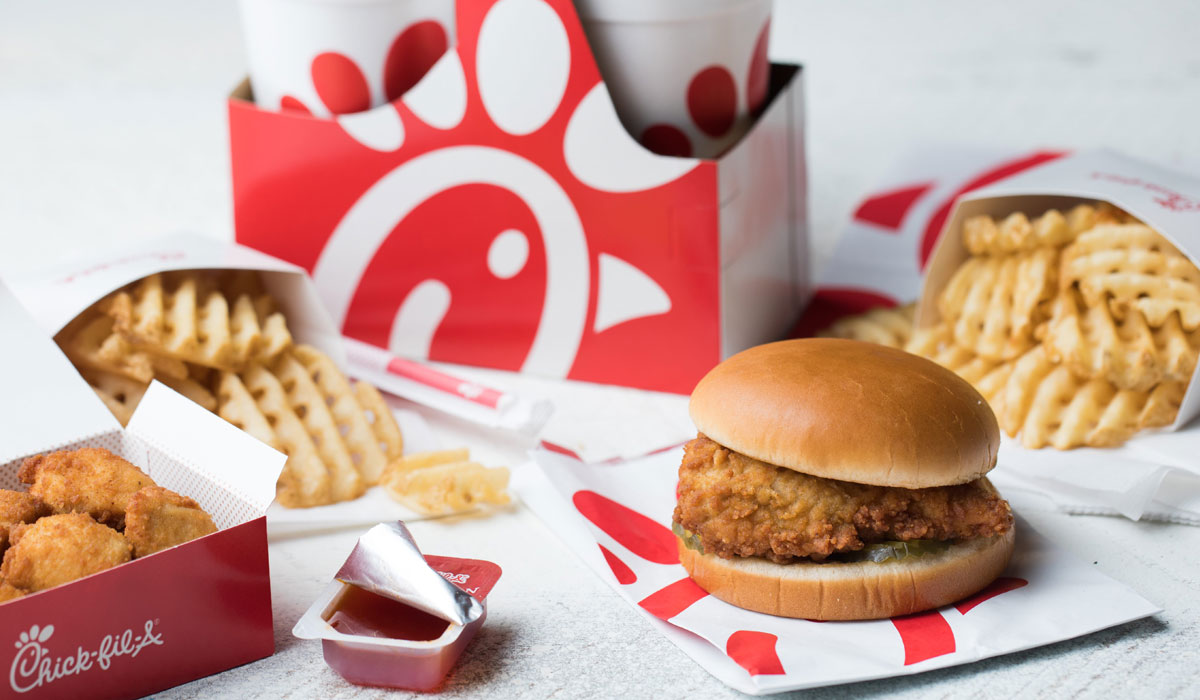There are a lot of ways to slice Chick-fil-A’s performance to illustrate its success, but one of the most transparent is its whitespace. There are currently seven restaurant chains in America in the $10 billion-and-above club, in terms of domestic systemwide sales. It goes as follows (2021 figures):
- 1. McDonald’s: $45.96B
- 2. Starbucks: $24.3B
- 3. Chick-fil-A: $16.7B
- 4. Taco Bell: $12.6B
- 5. Wendy’s: $11.1B
- 6. Dunkin’: $10.4B
- 7. Burger King: $10.03B
Collectively, those brands spanned 60,909 restaurants. And Chick-fil-A accounted for only 2,732 of them. The chain’s footprint makes up 4.5 percent of the country’s seven highest-grossing chains, yet is third overall in sales. The next-smallest brand, Wendy’s, has 5,938 units. Let’s rearrange.
By unit count (year-end 2021, domestic)
- 1. Starbucks: 15,450
- 2. McDonald’s: 13,438
- 3. Dunkin’: 9,244
- 4. Burger King: 7,105
- 5. Taco Bell: 7,002
- 6. Wendy’s: 5,938
- 7. Chick-fil-A: 2,732
You can fit more than five Chick-fil-A’s into Starbucks’ U.S. bubble.
Pulled out further, by largest quick-service brands nationwide (not just among the highest-earning), Chick-fil-A doesn’t show up until No. 18, ahead of Jimmy John’s and behind Popeyes.
The math behind this unicorn result is well-publicized and easy to calculate. Chick-fil-A made more per store last year than Olive Garden and IHOP combined. According to the company’s annual FDD, of Chick-fil-A’s 1,836 U.S. freestanding restaurants outside of malls (those open and operated for at least a full calendar year, from a total of 2,023), average annual sales volumes clocked in at $8.142 million in 2021, with 849 of those, or 46 percent, producing figures at or above. One operator recorded $17.16 million.
Roughly 35 percent of the pool produced annual sales volumes under $7.2 million; 34 percent between $7.2 and $9 million; and 31 percent above $9 million.
That $8.142 million figure was nearly 15 percent higher than Chick-fil-A’s 2020 result of $7.096 million. The overall AUV for 2021, mall stores included, came in at roughly $6.1 million.
Chick-fil-A’s 2021 revenue climbed to $5.8 billion, well ahead of the $4.3 billion it appreciated in 2020 and $3.8 billion the year prior. Comprehensive earnings of $1.198 billion sailed $715.9 million ($647 million in 2019).
As franchise and corporate store counts totaled 2,325, 2,219, and 2,117 in 2021, 2020, and 2019, respectively, systemwide sales lifted from $12.2 to $13.7 to $16.7 billion.
All while being closed on Sundays.
This isn’t to say Chick-fil-A isn’t growing: It finished 2021 with 2,311 franchised and company-operated locations (all but 76 are franchised)—a net change of 102 from last year’s 2,209. In the past three calendars, the chain has grown its domestic base by 322 locations.
The brand’s single-unit operator system has long guarded its vetting process. To put it plainly, Chick-fil-A is growing as fast as it wants to. And at the pace it feels can maintain its standards (and performance).
It adds intrigue to recent comments from CEO Andrew Cathy in a talk with The Wall Street Journal. Headed into the year, Chick-fil-A operated five franchised stores outside the U.S., all in Toronto. It opened its first Puerto Rico location in March 2022 . The company said in 2021’s year-end FDD it was “actively exploring” opportunities to continue franchised expansion in both, in addition to considering opportunities to scale “into other international locations.” The company previously touted Asia as a “big prize” target.
Cathy, who assumed the CEO role in fall 2021, succeeding his father, Dan T. Cathy, after an eight-year run, told The Journal Chick-fil-A plans to open restaurants in Europe and Asia by 2025, with stores in five international markets come 2030.
“We feel like it’s time to continue to innovate and try and test how we will do in international markets so that we can learn,” Cathy, just the third CEO in the chain’s history, said. It’s a plan that’s going to come with a $1 billion investment on Chick-fil-A’s part.
Key to the approach is consistency; Chick-fil-A plans to stick to what’s gotten it this far. Operators will still run one location and zero in on their market. Franchisees split profit with Chick-fil-A after paying fees.
The company has tested international waters before. Per The Journal, it left South Africa in 2001 after failing to generate enough awareness over a five-year period (Chick-fil-A was not the brand behemoth then that it is today. Nor is social media even a comparable channel overall). A U.K. mall location debuted west of London in 2019 but faced controversy from local gay-rights advocates. It closed several months later, the report said. Chick-fil-A today doesn’t contribute to political causes.
There are now eight stores in Canada to go along with three in Puerto Rico.
Executives told The Journal they expect global Chick-fil-A openings to perform similarly to those in the U.S. They’ll target countries in Asia and Europe with stable economics, dense populations, and a demand for chicken. One thing Chick-fil-A is still sorting through, Cathy said in the interview, was how to replicate the company’s supply chain aboard. It expected it would use local and existing U.S. suppliers.
From a menu angle, these stores could offer local twists, yet will likely hold to another Chick-fil-A hallmark—a repeatable, straightforward, simple menu built around chicken sandwiches, waffle fries, and milkshakes.
Speaking to the present international “chicken demand,” KFC closed 2022 with 27,760 locations. Of that, just 3,918 were stateside. KFC had 23,842 international stores after adding 2,419 new builds. There were 55 new U.S. builds. China accounted for 25 percent of KFC’s $8.307 billion in system sales last year (the U.S. was 15 percent). There are north of 8,500 China KFCs. Europe, excluding the U.K., was 12 percent of KFC’s sales and Asia 11 percent. KFC, famously, is a Christmas tradition for millions of Japanese consumers.
Popeyes struck a deal with Cartesian Capital Group last summer to develop in China over the next few years. It’s the same group that began developing sister brand Tim Hortons in China in 2019 and bumped the number to 450 by 2022.
Popeyes has major runway here, too. Of its 4,091 stores as of December 31, 1,170 came outside of the U.S. Year-over-year “rest of world” net restaurant growth was up 23 percent last year (6.1 percent in the U.S.)
Brand president Sami Siddiqui told QSR earlier there were just “a couple hundred” Popeyes in Asia.
Research from Euromonitor, as cited by The Journal, totals the Asia fast-food chicken sales tab last year at $33 billion. KFC held 39 percent of the market and Jollibee Foods Corp. was next. KFC also stood atop Western Europe’s $6.1 billion fast-food chicken arena.
Starbucks and McDonald’s outlined major China growth plans in recent quarters as well.
The international jump would mark perhaps Cathy’s broadest proposal since ascending to CEO.
He began his Chick-fil-A career in 2005, working two years as operator of a store in St. Petersburg, Florida. In 2007, he became part of the Support Center Staff as a franchisee selection consultant. After becoming the leader of franchisee selection, Andrew Cathy joined Chick-fil-A’s executive committee in 2015 as chief people officer before becoming head of operations. He then helmed international strategy in 2016 and was named VP of operations in 2019.
S. Truett Cathy, Dan Cathy’s father, opened the first Chick-fil-A in 1967 in Atlanta’s Greenbriar Shopping Center. He started the business, in earnest, in 1946, when he and his brother, Ben, opened an Atlanta diner known as The Dwarf Grill (later renamed The Dwarf House).
Dan Cathy became president and COO in 2001 and CEO in 2013. When he was first appointed president and COO, the chain earned $1.24 billion in sales and had just over 1,000 restaurants. By the time he became CEO, the company collected sales of $5.78 billion across 1,881 restaurants.










